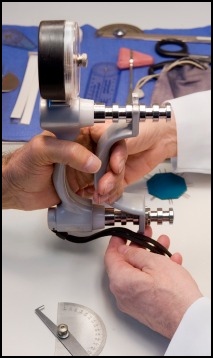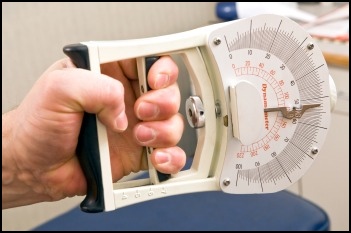The Grip Strength Test:
Ways To Measure Your Grip
Doing an accurate grip strength test can be difficult and annoying. You don't have the fancy equipment, you don't know exactly what to do, etc., etc.
Weight training is one of the best methods of strength training! If you want to start weight training safely and effectively, with the best info, diet, and routines, check out the 5 Day Beginner Weight Training Course!
But here are some simple ways to measure your grip strength.
Whether you have your own hand dynamometer or just a bathroom scale, lets measure your grip and see how good it is compared to everyone else's.
Info About Doing A Grip Strength Test

Measuring your grip tells you how much force you exert when you close your hand. Some people use it to gauge overall body strength, but there really isn't a good correlation there.[1]
The best way to measure your grip is by using a hand dynamometer, a special machine designed to do a grip strength test. You can see a picture of one at the right and another one below.

Both of those dynamometers were made to test a full grip. There are other, more specialized, ones to do grip strength tests of your pinch strength (your thumb pinching towards your other 4 fingers), but that's beyond the scope of what we're doing here.
While most hand dynamometers are expensive ($150+), you can use them at a doctor's office or you might find them at your gym.
Don't drop a ton of money without looking around first.
Cable tensiometers are another type of measuring device, used to measure force in other body parts mostly, but you can use them for your hand. They use a cable attached to a stationary object, and you contract your muscles and pull against it. Sort of like pulling on a scale you might find in the produce section of your grocery store.
They are less common than dynamometers, though they're great for doing a grip strength test too.
So, onto the tests!
How to Use a Hand Dynamometer to
Test Grip Strength
For this you need a hand dynamometer that is adjusted for your hand size. The method below is outlined in Lifetime Physical Fitness and Wellness: A Personalized Program, and is a basic one for measuring hand strength.[2]
- Position the middle bones of your fingers so that they rest on the forward end of the dynamometer grip - the part you'll be gripping. (See the pictures above)
- Hold your arm at the side of your body with your hand forward, elbow at a 90 degree angle, elbow about 2 inches away from your body.
- Do 2-3 'practice' grips. Get a feel for gripping the dynamometer.
- Tense your hand as hard as possible for a few (3 - 5) seconds. Don't move any other parts of your body, don't help with other muscles, etc.
- Do 3 trials, waiting about a minute to recover between each one.
- Use the highest test score as your grip strength.
Simple Version #1:
Grip Strength Test With A Bathroom Scale
This is the poor man's version, if you can't get hold of a dynamometer. You need more muscle control so that you don't mess up the test.
You'll need a scale, hangboard (a bar or something to hold onto), and a stopwatch.[3]
- Stand on the scale and measure your bodyweight.
- Then, grab the bar/hangboard and, without bending your elbows and not using any part of your body other than your hands, tense your hands and pull yourself up for 5 seconds.
- Record what the scale says for the 5 seconds you're tensing your hands.
- How much you weigh - how much you weigh while tensing your hands = your grip strength in pounds.
This will tell you, with a little less accuracy than the dynamometer, how much grip strength you have. If you're interested you can use this method to find out what percentage of your bodyweight you can grip by doing this equation...
Your Bodyweight Percentage Gripped = 100 x [ 1 - (Weight On Scale When Gripping / Your Bodyweight) ]
Example:40.7% = 100 x [ 1 - ( 80 lb. / 135 lb.) ]
This is especially useful for people who use their grip to move their bodyweight, such as climbers and gymnasts. This method was originally presented in Climbing Your Best by Heather Sagar.
Simple Version #2:
Grip Strength Test With A Cable Weight Machine
For this method you need a cable weight lifting machine and a friend. Get them both and...[4]
- Lie on the ground, with the fingers of one hand just touching the grip of the cable. The cable should be set to a low weight.
- Get a friend to help hold your torso down, brace your body, and hold at the elbow. For the test, only your hand should be contracting.
- Contract your hands and close your grip.
If you can close your hand easily, put slightly more weight on the cable until you can't close you grip. If you can't close your grip, make it lighter until you can close your hand. You've got your result when you're at the limit of what your grip can close.
What's A 'Good' Weight For A Grip Strength Test?
It can be fun to know how your grip compares to everyone else's. Here's some idea of what a good, and bad, grip is...
Average Adult Grip Strength
in Kilograms (Kg)5
| Classification | |
|
|
|
| Excellent | |
|
|
|
| Good | |
|
|
|
| Average | |
|
|
|
| Below Average | |
|
|
|
| Poor | |
|
|
|
The numbers given above are great for 'general' info. But it's handy to be more specific.
If you're looking for a more complete breakdown, take a look at the graphs below. They break down different information by age group as well as sex.
Just keep in mind that the grip values are for the strength of both your hands' grips, added together.
In Kilograms (Kg) For...
15 - 19 Year Olds6
| Rating | |
|
| Excellent | |
|
| Very Good | |
|
| Good | |
|
| Fair | |
|
| Needs Improvement | |
|
| Rating | |
|
| Excellent | |
|
| Very Good | |
|
| Good | |
|
| Fair | |
|
| Needs Improvement | |
|
| Rating | |
|
| Excellent | |
|
| Very Good | |
|
| Good | |
|
| Fair | |
|
| Needs Improvement | |
|
| Rating | |
|
| Excellent | |
|
| Very Good | |
|
| Good | |
|
| Fair | |
|
| Needs Improvement | |
|
| Rating | |
|
| Excellent | |
|
| Very Good | |
|
| Good | |
|
| Fair | |
|
| Needs Improvement | |
|
| Rating | |
|
| Excellent | |
|
| Very Good | |
|
| Good | |
|
| Fair | |
|
| Needs Improvement | |
|
Conclusion
So... There are several kinds of grip strength test you can do. Test how strong your hands are, make them stronger, show off by crushing raw eggs at parties.
Just doing a grip strength test won't get you anywhere. Work your grip damn hard to get it stronger.
Oh, and be sure to sign up for the e-zine Starting Strong to get monthly strength training, exercise, and diet tips e-mailed to you - and access to the free e-book Train Smart, Eat Smart: Exercise Nutrition Hacks!
• Click here to learn more about Hand Grip Exercise!
OR
The Grip Strength Test - Ways To Measure Your Grip
References:
1. Hoeger, Wener W. K., and Hoeger, Sharon A. 2010. Lifetime Physical Fitness and Wellness: A Personalized Program. Brooks/Cole Pub Co. Pp. 210.
2. Ibid.
3. Sagar, Heather Reynolds. 2001. Climbing Your Best: Training to Maximize Your Performance. Mechanicsburg, PA: Stackpole Books. Pp. 9.
4. Ibid. Pp. 10.
5. Heyward, Vivian H. 2010. Advanced Fitness Assessment & Exercise Prescription. Champaign, IL: Human Kinetics. Pp. 133.
6. Ibid.
7. Ibid.
8. Ibid.
9. Ibid.
10. Ibid.
11. Ibid.
Search CST...
|
Tweet Follow @Aaron_CST |
|
"About 2 weeks ago I read all the ab strengthening stuff on your site because I decided I wanted to be strong, instead of having a lot of belly fat. So I started eating healthier, running, exercising, you name it - everything your site said to do to help. Now I am noticing a real difference! Thank you for making this. :D xD" ~ Julia |
|
[This calorie calculator is] the most useful tool on the web that I can find… Also, I compared the calories calculated by your calculator to the calories calculated by the treadmill at my gym, and they're within a couple calories of each other, so yours is as accurate as we're going to get. REALLY AWESOME TOOL. I love it and depend on it. Thank you sooooo much for making this available." ~ Galit Sharon Marcus |
|
Thank you very much, I was too lean before 2 years (55 Kgs), after the gym now I'm 72kgs, all the muscles have developed... when someone hand shakes with me it can be squeezed easily, they're making fun of me! ~ Tamil Arasan |






New! Comments
Have your say about what you just read! Leave me a comment in the box below.